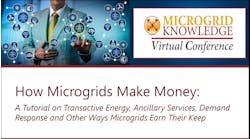Siemens and AES have joined forces to create Fluence, a joint venture with an ambitious goal to capture major segments of the energy storage market worldwide.
The deal brings together two mega-energy companies. Siemens offers a range of energy services and technology in 160 countries. AES serves 10 million utility customers and operates 30 GW of generation in 17 countries.
Fluence is likely to recalibrate the energy storage playing field — and perhaps the microgrid arena as well. Siemens has a strong reach into the microgrid market with its advanced controller. Energy storage is often included in new microgrids.
Based in Washington, D.C., Fluence will be jointly owned and controlled by the two companies, and operated as an independent 50-50 venture. Fluence will leverage Siemens’ global presence and AES’ work installing utility-scale storage over the last decade. In addition to its US headquarters, Fluence will have offices in Erlangen, Germany and other select cities.
AES already has 200 MW of energy storage installed in seven countries, but wants a broader international scope. Speaking Tuesday from AES’ 2017 Innovation Congress in Washington, D.C., AES CEO Andres Gluski said that his company realized it needed a technology partner with greater reach to meet its goals.
“We really found a meeting of the minds in Siemens,” Gluski said.
Besides its geographic reach, Siemens brings to the partnership an energy storage platform of its own. Called Siestorage, it is geared toward smaller customers. It complements AES’ energy storage platform, Advancion, which is for larger companies, he said.
Watch Siemens and AES executives discuss Fluence.
Together, Siemens and AES can offer “the complete gamut of products from commercial & industrial to the very largest utility applications,” he said.
In addition to its scale and energy storage platform, Siemens plans to offer the breadth of its portfolio to Fluence, which includes microgrid controllers, balance of plant technology and electric distribution equipment, said Kevin Yates, president of Siemens Energy Management Division.
AES was ranked number one energy storage integrator by Navigant Research and Siemens was ranked number four. “So, without a doubt we will be the leader in this market,” Gluski said. “Siemens and AES ambition is nothing less than to be the global leader in lithium-ion based energy storage applications in the world.”
Fluence will pursue a market that IHS expects to grow from 3 GW to 28 GW in five years, creating a $45 billion opportunity, Gluski said.
The transaction is expected to close in the fourth quarter of calendar year 2017 following regulatory approvals.
Together, the two companies have deployed or have been awarded 48 projects totaling 463 MW of battery-based energy storage across 13 countries, including the world’s largest lithium-ion battery-based energy storage project near San Diego, California.
“As the energy storage market expands, customers face the challenge of finding a trusted technology partner with an appropriate portfolio and a profound knowledge of the power sector. Fluence will fill this major gap in the market. With the global reach of an experienced international sales force as well as Siemens’ leading technology platform Siestorage at its disposal, Fluence will be perfectly equipped to serve this very interesting market,” said Ralf Christian, CEO of Siemens’ Energy Management Division.
How will Fluence change the energy storage and microgrid markets? Post your thoughts on our LinkedIn Group, Distributed Energy Resources.






